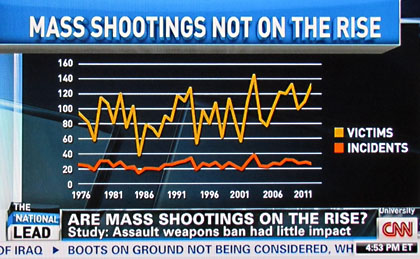
I just caught a few minutes of the Brazil-Croatia World Cup opener (“patient possession football” said the announcer, which apparently means kinda slow and humdrum), and before I knew it, it was halftime. So I switched over to CNN to see if anything was going on, and caught a pretty good example of how to miss the point with statistics. The chart at issue is on the right. According to James Alan Fox of Northeastern University, mass shootings aren’t on the rise,  even though it might seem that they are. But there’s something missing from this analysis, and regular readers who know my hobbyhorses should be able to guess what it is.
even though it might seem that they are. But there’s something missing from this analysis, and regular readers who know my hobbyhorses should be able to guess what it is.
Is it the fact that the yellow line does, in fact, seem to be rising steadily? No. An eyeball analysis suggests that it is, but it’s not a big rise, and anyway, it’s probably accounted for by population growth.
Nope, it’s this: Since 1993, the rate of violent crime in America has plummeted by half. That’s the background to measure this against. In general, America has become a much safer, much less lethal place, and yet mass shootings have remained steady. Compared to the background rate of violent crime, mass shootings have doubled. Why?
And here’s an equally interesting question: between 1976 and 1993, violent crime increased by a significant amount, but mass shootings remained steady. Again, why?
Raw numbers are a starting point, but they don’t tell the whole story. If Americans, on average, are considerably less violent than they were 20 years ago, shouldn’t mass shootings be down? The answer presumably, is that mass shootings are actually up when you measure them correctly, or else that mass shootings have nothing to do with violent tendencies in general. My guess is the latter, and it would be genuinely interesting to hear from experts about why this is.








